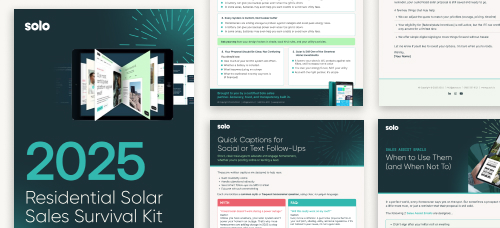The Residential Clean Energy Credit (25D) has been a long-time favorite in solar, helping millions of homeowners go solar with a 30% federal tax credit. But it’s expiration is looming and the market is already shifting. TPO financing is stepping into the spotlight, projected to account for nearly 70% of solar deals next year. This change doesn’t mean your deals should stall. For contractors, TPO presents a strong path forward while maximizing deal value through 2026 and beyond.
That shift comes with new expectations. Unlike direct ownership, TPO deals are tied to portfolios reviewed by lenders and investors, meaning proposals have to be airtight. With the right approach, your proposals can be lender-ready, maximize credits for your TPO partner, and become the contractor they return to.

What Makes TPO Different
Under 25D, all a homeowner needed was a dated invoice to claim the credit on their taxes. With TPO, the project itself is treated as a financial asset. Lenders and investors need confidence that the system will perform as promised, which means the documentation has to be far more detailed and precise than in a simple direct-ownership sale.
The IRS requirements for 45Y and 48E are fairly minimal, mainly “placed in service” and ownership structure. The stricter standards come from TPO lenders. To keep deals fundable and compliant, they expect:
- Bankable production data with inputs verified by your design platform or third-party design team, and clear performance assumptions.
Clean, centralized documentation that can be exported and audited without delays. - Clear compliance records including AHJ-specific permits, approvals, and inspection sign-offs.
- Domestic content and equipment verification when SKUs are tied to incentive adders.
These higher standards aren’t a barrier. They’re an opportunity to stand out. Put simply, TPO doesn’t change the fundamentals of selling solar. It just raises the bar on how clean, accurate, and compliant your proposals need to be. Contractors who meet these standards consistently make themselves more attractive TPO partners and are better positioned to benefit from credits like 45Y and 48E.
Understanding the Tax Credits That Drive TPO
Even without 25D, TPO projects still qualify for powerful incentives. Two credits now drive the economics: 45Y, which rewards actual production over time, and 48E, which gives TPO providers an upfront boost based on system costs. Together, these credits help offset expenses and make TPO pricing more competitive for homeowners.
For contractors, the difference comes down to how you document and present your projects:
- For 45Y: Proposals should include reliable production estimates tied to verified data sources, showing how systems will perform over their lifetime.
- For 48E: Cost details must align clearly with system design and equipment, making it easy for partners to claim the upfront credit.
- For both: A consistent paper trail—clean design files, equipment SKUs, and compliance records—removes doubt for lenders and keeps funding on track.
Together, they give TPO partners a strong way to offset costs and strengthen ROI, which can translate into more competitive pricing or better terms for homeowners.
Why Documentation and Proposals Matter
In TPO deals, a proposal is more than a sales tool—it’s the foundation for funding. Lenders want to see production data, compliance details, and equipment specs that prove every project is reliable. Strong proposals speed up funding; weak ones slow everything down.
How to Make Proposals Lender-Ready
- Deliver bankable numbers: Use design tools that meet lender accuracy standards. GoodLeap reports rejecting up to 70% of proposals from tools that only cover the basics.
- Centralize compliance data: Version history, timestamps, shading models, and AHJ rules should all be in one system for fast review.
- Provide structured files: PDFs work for homeowners, but lenders need organized files with labeled fields they can pull into their systems.
Nailing these details gives TPO partners confidence that every deal is ready to fund. The easiest way to get there is by using tools built for lender requirements from the start.
The Right Tools for TPO Success
Human effort can carry a lot of deals over the finish line, but inconsistent tools and scattered documentation create gaps that slow funding and hurt trust. TPO work moves faster and smoothly when your systems can:
- Keep proposal and compliance data in one place, always accessible.
- Track versions, timestamps, and approvals so nothing gets lost.
- Export lender-ready files with structured fields and full documentation.
Meet or exceed the accuracy standards top lenders require.
That’s where Solo comes in. Solo’s design-first platform is built for accuracy, compliance, and clean documentation from the start. Designed to help your team deliver proposals that aren’t just sales-ready, but lender-ready every single time.
Ready to make every TPO deal smoother?
When proposals and documentation are airtight from day one, your TPO partners can move quickly, capture credits, and fund with confidence. That’s the difference between just “selling solar” and being the contractor every TPO partner wants to work with. If you’d like to see how See how Solo can help standardize this process and Book a Demo with our team.


